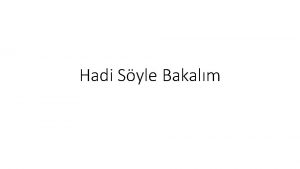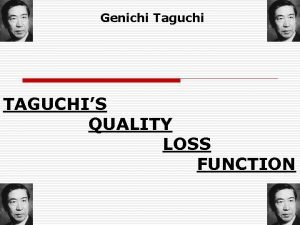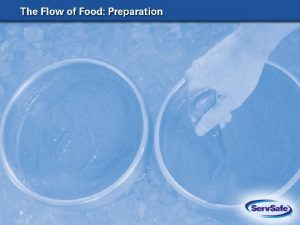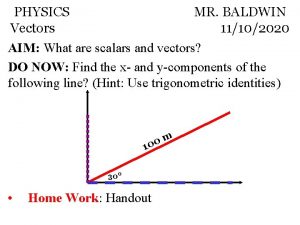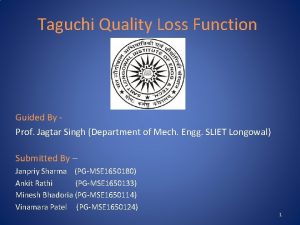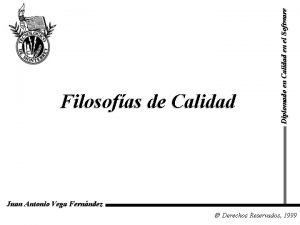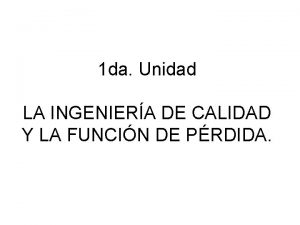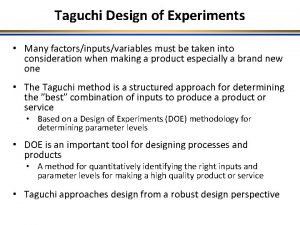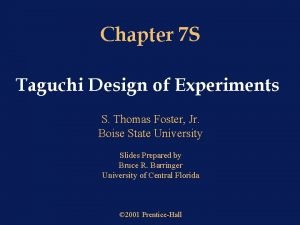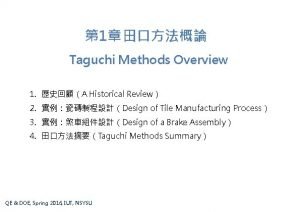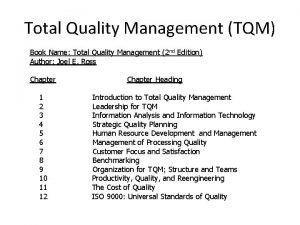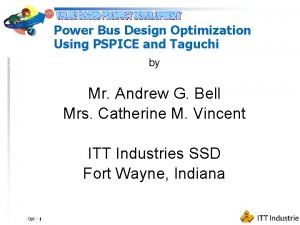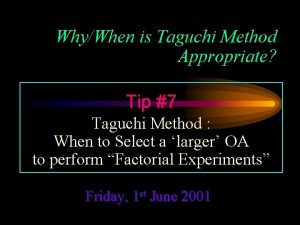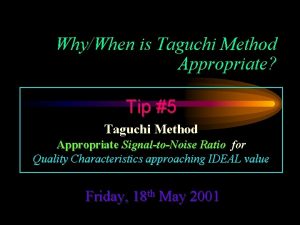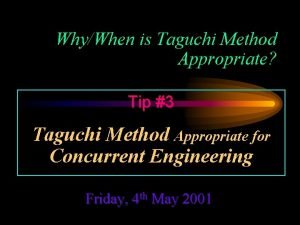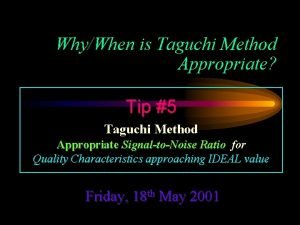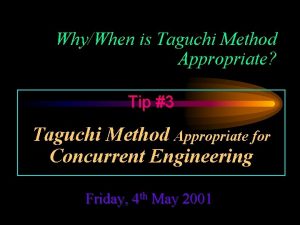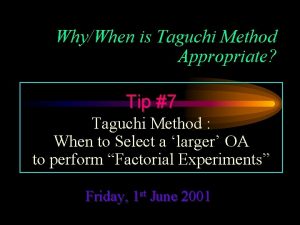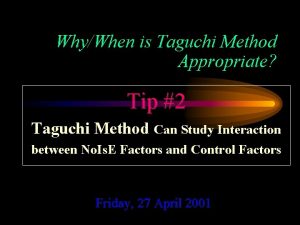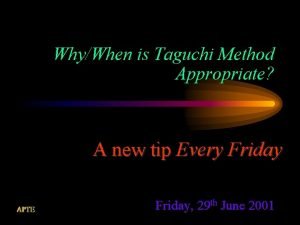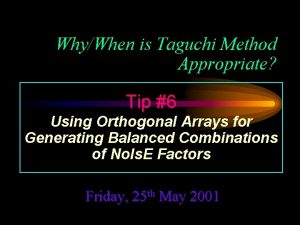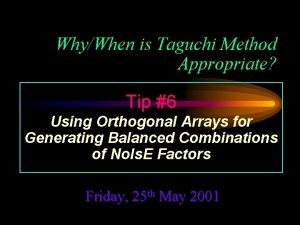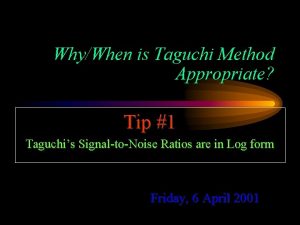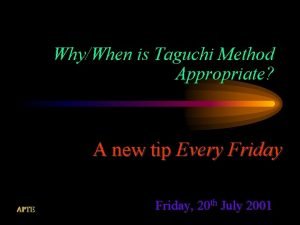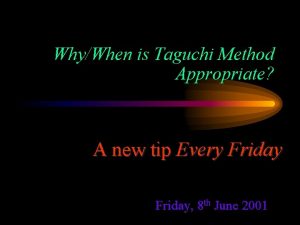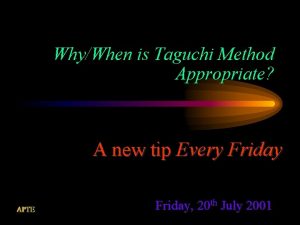WhyWhen is Taguchi Method Appropriate Tip 2 Taguchi















- Slides: 15

Why/When is Taguchi Method Appropriate? Tip #2 Taguchi Method Can Study Interaction between No. Is. E Factors and Control Factors Friday, 27 April 2001

Tip #2 Taguchi Method Does not STUDY : Interaction between Control Factors • Use of Orthogonal Array implies that we can not or ought not study interactions between control factors. We include only control factors that do not interact with each other, say A, B, C and D. This is shown in next slide (use L 9 array) Friday, 27 April 2001

Taguchi Method Does not STUDY : Interaction between Control Factors Expt. No. Control Factor A Control Factor B Control Factor C Control Factor D 1 1 1 2 2 2 3 1 3 3 3 4 2 1 2 3 5 2 2 3 1 6 2 3 1 2 7 3 1 3 2 8 3 2 1 3 9 3 3 2 1 Friday, 27 April 2001

Taguchi Method can study Interaction between Control Factor ‘R’ and (A, B, C or D) with repeated use of OA • If there is a single control factor ‘R’ that may have strong interactions with several control factors, then we can simply repeat the entire OA experiments at two different levels of ‘R’ This is shown in next slide (use two sets of L 9 array) • Obviously, ALL interactions, between ‘R’ and any one of A, B, C and D, can be studied) Friday, 27 April 2001

Taguchi Method can study Interaction between Control Factor ‘R’ and (A, B, C or D) with repeated use of OA SPINDLE SPEED Expt. No. Control Factor A Control Factor B Control Factor C Control Factor D 600 rpm 600 rpm 600 rpm 1 2 3 4 5 6 7 8 9 1 1 1 2 2 2 3 3 3 1 2 3 2 3 1 2 1 2 3 3 1 2 2 3 1 900 rpm 10 1 1 900 rpm 11 1 2 2 2 900 rpm 12 1 3 3 3 900 rpm 13 2 1 2 3 900 rpm 14 2 2 3 1 900 rpm 15 2 3 1 2 900 rpm 16 3 1 3 2 900 rpm 17 3 2 1 3 900 rpm 18 3 3 2 1 Friday, 27 April 2001

Taguchi Method can study Interaction between a Noise Factor ‘X’ and (A, B, C or D) with repeated use of OA • If there is a single noise factor ‘X’ that may have strong correlation with several control factors, then we can simply repeat the entire OA experiments at two different levels of ‘X’ This is shown in next slide (use two sets of L 9 array) • Obviously, ALL correlations between ‘X’ and any one of A, B, C and D can be studied Friday, 27 April 2001

Taguchi Method can study Interaction between a Noise Factor ‘X’ and (A, B, C or D) with repeated use of OA Material Hardness Expt. No. Control Factor A Control Factor B Control Factor C Control Factor D soft soft soft 1 2 3 4 5 6 7 8 9 1 1 1 2 2 2 3 3 3 1 2 3 2 3 1 2 1 2 3 3 1 2 2 3 1 HARD 10 1 1 HARD 11 1 2 2 2 HARD 12 1 3 3 3 HARD 13 2 1 2 3 HARD 14 2 2 3 1 HARD 15 2 3 1 2 HARD 16 3 1 3 2 HARD 17 3 2 1 3 HARD 18 3 3 2 1 Friday, 27 April 2001

Taguchi Method can study Interaction between a Noise Factor ‘X’ and (A, B, C or D) with repeated use of OA • The OA based experiments, say L 9 as in this example, require that two samples are made for each row (each row indicates one combination of control factors A, B, C and D) • The measured values of quality characteristics are noted for that row • Analysis then gives ‘best’ settings for control factors A, B, C and D that would give least sensitivity to the noise factor, say hardness as in this example Friday, 27 April 2001

This IS equivalent to the repeated use of OA shown earlier NOISE FACTOR Material Hardness Expt. No. Control Factor A Control Factor B Control Factor C Control Factor D Level 1 Level 2 1 /10 1 1 Soft HARD 2 /11 1 2 2 2 Soft HARD 3 /12 1 3 3 3 Soft HARD 4 /13 2 1 2 3 Soft HARD 5 /14 2 2 3 1 Soft HARD 6 /15 2 3 1 2 Soft HARD 7 /16 3 1 3 2 Soft HARD 8 /17 3 2 1 3 Soft HARD 9 /18 3 3 2 1 Soft HARD Friday, 27 April 2001

Earlier Tips Links below 15. Taguchi Method Friday, 27 th July 2001 “inner” L 9 array with “outer” L 4 and L 9 No. Is. E arrays 14. Taguchi Method Friday, 20 th July 2001 “inner” L 18 array with “outer” L 4 and L 9 No. Is. E arrays 13. Taguchi Method Friday, 13 th July 2001 Why/When is Taguchi Method not Appropriate? Tips 12, 11, 10

Earlier Tips 12. Taguchi Method Links below Friday, 6 th July 2001 “inner” L 8 array with “outer” L 4 and L 9 No. Is. E arrays 11. Taguchi Method Friday, 29 th June 2001 Useful at ALL Life-stages of a Process or Product 10. Taguchi Method Friday, 22 nd June 2001 Performs Process “centering” or “fine tuning” Tips 9, 8, 7

Earlier Tips 9. Taguchi Method Links below Friday, 15 th June 2001 Identifies the “right” No. Is. E factor(s) for Tolerance Design 8. Taguchi Method Friday, 8 th June 2001 Finds best settings to optimize TWO quality characteristics Simultaneously 7. Taguchi Method Friday, 1 st June 2001 When to select a ‘Larger’ OA to perform “Factorial Experiments” Tips 6, 5, 4

Earlier Tips 6. Taguchi Method Links below Friday, 25 th May 2001 Using Orthogonal Arrays for Generating Balanced Combinations of No. Is. E Factors 5. Taguchi Method Friday, 18 th May 2001 Signal-to-Noise Ratio for Quality Characteristics approaching IDEAL value 4. Taguchi Method Friday, 11 th May 2001 improves " quality “ at all the life stages at the design stage itself Tips 3, 2, 1

Earlier Tips Links below 3. Taguchi Method Appropriate for Concurrent Engineering Friday, 4 th May 2001 2. Taguchi Method can study Interaction Friday, 27 th April 2001 between Noise Factors and Control Factors 1. Taguchi’s Signal-to-Noise Ratios are in Log form Friday, 6 th April 2001

end
 Takatuka bilmecesi
Takatuka bilmecesi Taguchi
Taguchi What are the four acceptable methods of thawing food
What are the four acceptable methods of thawing food Squash method onion root tip
Squash method onion root tip Physics vectors
Physics vectors Taguchi quality loss function
Taguchi quality loss function Taguchi array selector
Taguchi array selector Genichi taguchi
Genichi taguchi Definicion de calidad deming
Definicion de calidad deming Taguchi array selector
Taguchi array selector Funcion de perdida de taguchi ejemplos
Funcion de perdida de taguchi ejemplos Worked out
Worked out Thomas taguchi
Thomas taguchi Genichi taguchi
Genichi taguchi Praise analysis
Praise analysis Taguchi
Taguchi
